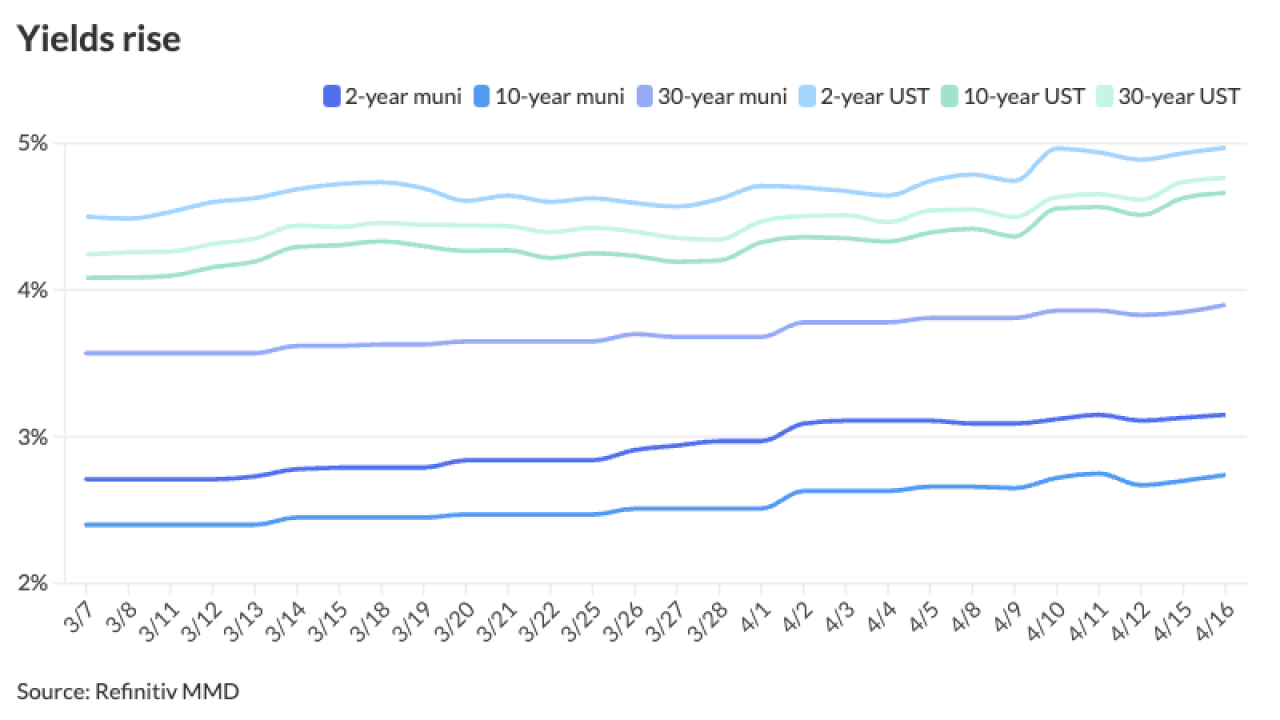
The municipal bond market continues to name winners and losers.
Muni issuers sold $41.38 billion in bonds in June, according to Thomson Reuters, an 18.5% decline from June 2008.
The number tells an incomplete story, and not only because June 2008 was several lifetimes ago, in bond investor years.
Investors are still buying plain-vanilla fixed-rate bonds. The decline in bond volume in June stemmed entirely from the collapse in variable-rate issuance.
First the good news: issuers looking to sell general purpose bonds at a fixed rate have access to a market with strong demand from retail investors and record flows into mutual funds.
Issuers borrowed $37.19 billion at a fixed rate in June, a 25.6% increase over last June. Fixed-rate issuance for the first half of the year is up 15.3% over the first half of 2008.
Fueled by Build America Bonds, issuance of taxable debt catapulted to $8.09 billion in June, by far the highest share of the market ever for taxables at almost 20%.
"The market as a whole has performed decently recently," said Phil Fischer, head of municipal strategy at Bank of America-Merrill Lynch. "We know that the demand for munis has been quite strong, especially from private clients and mutual funds."
Now the bad news: issuers with stressed credit or hopes for selling variable-rate paper are not finding much receptiveness in the bond market.
Variable-rate sales tumbled to $3.15 billion in June from $20.5 billion in the same period last year, hampered by banks' unwillingness to provide letters of credit at what issuers consider affordable prices.
Volume in bonds backed by letters of credit plummeted 90.9% during the month.
Short-put variable-rate paper constituted 5.6% of total issuance in June. So far this year, less than 10% of issuance has been short-put variable-rate debt. The last time short-put variable rate debt contributed less than a 10th of the market for a year was 1998.
At this time last year, issuers had sold $75.17 billion in short-put variable-rate debt for the year. This year, they have sold $15.3 billion. Excluding short-put variable-rate debt, bond sales jumped 14.3% in the first half of the year.
Sectors associated with less-sterling credit quality also had trouble floating debt. The electric power, environmental facilities, health care, housing, and public facilities sectors all suffered issuance declines of more than 40%.
"The cost of credit for anybody who's got a particular credit story can be quite inhibiting," Fischer said. "The rest of the market that isn't credit-impacted seems to be flowing along pretty well."
Further evidence of the bifurcation can be found in the par volume relative to the number of issuers, according to Fischer.
In June, 970 issuers sold bonds, compared with 1,311 issuers in June 2008. That means issuers tapping the market during the month borrowed an average of $42.7 million.
That is 55% higher than the average deal size since 2000. The average bond size in a month has been higher only four times since the early 1980s.
The significance of this, Fischer said, is the market is increasingly dominated by big issuers closing big deals. Smaller issuers looking to borrow smaller amounts are composing a smaller share of the market.
Smaller issues tend to be less liquid, Fischer said. Along with credit quality investors are increasingly prizing liquidity.
"I've seen this market as two markets," said Phil Condon, head muni strategist at DWS Investments. "The fixed-rate market, which I think is pretty healthy, and the variable-rate market, which is dependent on liquidity from the banks, and that is still stressed."
Fixed-rate bond sales continue to climb even though the interest-rate environment and the shape of the yield curve make it less sensible for municipalities to refinance debt.
About 24% of bond volume since the early 1980s has been issuers selling refunding bonds to refinance existing debt.
In June, refunding bonds contributed 17.6% of the total. Excluding refunding bonds, issuance only declined 3.2% from June 2008. The trends, present in much of 2009, were magnified in June.
For the first half of the year, issuance was down 16.2%; in June it was down 18.5%. Year-to-date, fixed-rate issuance is up 15.3%; in June it was up 25.6%.
Year-to-date refundings are down 36.9%; in June, a drop of 43.2%.
June is a historically busy month. Many issuers' fiscal calendars begin July 1, and so a lot of bonds mature in June and issuers are often eager to borrow.
Almost 10.4% of all municipal debt since 1982 has been floated in June, and the average sequential increase from May is 22%.
That said, issuance in June increased 35% from May. In 330 months of data from Thomson Reuters spanning almost three decades, issuance has increased more than 35% sequentially only 56 times.
The biggest deals of the month were a $4.12 billion tax-exempt issue from the Puerto Rico Sales Tax Financing Corp. and a $1.22 billion taxable bond from the same issuer. The Dallas Area Rapid Transit Authority sold a $1 billion taxable bond, and the New York State Dormitory Authority sold a $787.9 million issue.
Bonds qualified for purchase by banks doubled to $2.91 billion as the federal government expanded the size of eligible deals.
Insured bonds dwindled to $1.85 billion from $9.51 billion while the number of issues backed by insurance halved. Of the bonds coming to market in June, only 4.5% were insured.
Fischer said a few years ago people would have had trouble believing that. Insurance penetration peaked at 57.1% in 2005, and was 46.8% only two years ago.





